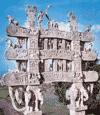- Sanchi sculpture
-
Early Indian sculpture that embellished the gateways of the Buddhist relic mound called the Great Stupa at Sanchi, in Madhya Pradesh, a magnificent monument of the 1st century BC.The two square posts of each gateway are topped by capitals of sculptured animals or dwarfs, surmounted by three crossbars that end in spirals and are covered with crowded relief sculptures depicting events of the Buddha's life. In the angle between the lowest crossbar and the pillar are sensuous figures of female earthly spirits.
 Art ResourceEB Inc.
Art ResourceEB Inc.* * *
▪ Indian artearly Indian sculpture that embellished the 1st-century-BC gateways of the Buddhist relic mound called the Great Stupa (stupa No. 1) at Sānchi, Madhya Pradesh, which is one of the most magnificent monuments of its time. The region of Sānchi, however, like the great centres at Sārnāth and Mathura, had a continuous artistic history from the 3rd century BC to the 11th century AD.Sānchi is the site of three stupas: stupa No. 1, an Aśokan foundation enlarged in succeeding centuries; No. 2, with railing decorations of the late Śuṅga period (c. 1st century BC); and No. 3, with its single toran (ceremonial gateway) of the late 1st century BC–1st century AD. Other features of interest include a commemorative pillar erected by the emperor Aśoka (c. 265–238 BC); an early Gupta temple (temple No. 17), early 5th century, with a flat roof and pillared portico; and monastic buildings ranging over several centuries.The four torans of the Great Stupa added in the 1st century BC are the crowning achievements of Sānchi. Each gateway is made up of two square posts topped by capitals of sculptured animals or dwarfs, surmounted by three architraves, which end in spirals not unlike the rolled ends of scrolls. On the topmost crossbar were placed originally the trident-like symbol of the triratna and the wheel of the law. The crossbars and the intervening square dies between them are covered with relief sculpture depicting the events of the Buddha's (Buddha) life, legends of his previous births (Jātaka stories), and other scenes important to early Buddhism (such as the emperor Aśoka's visit to the Bo tree), as well as auspicious symbols. Inscriptions give the names of the donors of the relief; one commemorates the gift of the ivory workers of Vidisha and has given rise to the suggestion that there the tradition of working in ivory may have been translated into stone. The reliefs are deeply carved, so that the figures seem to swim against a sea of dark shadow cast by the strong Indian sun. The panels, which employ the device of continuous narration, are crowded, rich, and brimming with life. The Buddha is depicted throughout in symbolic form, by a wheel, an empty throne, or a pair of footprints.Set in the angle between the pillar and the lowest crossbar of the gateways are magnificent figures of female yakshas (yaksha) (earthly spirits). They serve no true architectural purpose, yet their pose, with leg thrusting against the post and arms entwined in the branches of a tree, is appropriate to the space they fill. A damaged torso of a Sānchi yaksha is preserved at the Museum of Fine Arts, Boston. The sculptural treatment shows considerable advance over similar yaksha figures at Bhārhut (stupa of the mid-2nd century BC, in Madhya Pradesh). There is much smoother movement in the flexed bodies and more attention given to the open space around the figure. The fertility aspect of the union of maiden and tree is emphasized in the heavy breasts and hips and the transparent draperies. The smooth modeling and roundness of forms combine to give the yaksha figures a wonderful vitality and a sense of “swelling from within” characteristic of the finest Indian sculpture of all periods.* * *
Universalium. 2010.
